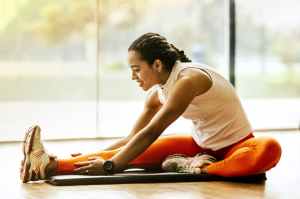This article is part one of two to help you deal with easing a stiff back and shoulders from sitting.
This article deals with your set up and the second article with Yoga movements and stretches to relieve the stiffness associated with sitting for long periods.
The human body is the most amazing thing you will ever own. Take care of it.
If you maintain a posture regularly, your body will get better at holding this position to support what you do. This means that if you are sitting for your job, your body adapts to this need to sit for long periods.
However, this can also lead to soreness and stiffness when you then get up from your desk or get out of the car you’ve been driving. You might sit again on the way home on public transport or in the car and then you sit to eat and as you relax at home. Your body as a consequence is trapped in the same movement pattern everyday.
So whether you are stiff from sitting at a desk or long days of driving, here are some tips to help you relieve it.
If you sit to work in anyway, you are probably in a mild forward fold all day with your arms curved forward. Any movement in the opposite direction will help break up this pattern and resulting stagnation.
Little amounts and often. It’s not good for your body to jump up suddenly from a few hours of work and attempt the deepest back bend you’ve seen a picture of on instagram. Even if you have the skeletal permission to do so – going from one extreme to the other won’t serve you!



Delivery drivers are often at risk of hurting their back, as they sit for long periods, jump out and start shifting heavy boxes around. Your back is for life!
There are things you can do all day, everyday as you sit and you need to build in movement to break up your “holding pattern”. Yes go to a Yoga class, pilates, go for a swim, run or head to the gym. These are all things that can help. You also need to think about the things you can do as part of your day to day routine and build in them in to your work practices. This will help your awareness, stiffness, overall health and well being.
Posture.
How you sit is important. Your daily habits are what eventually catch up with you.
Rather than go into work and try to sit bolt upright for several hours. Spend the first few days noticing your habits.
Firstly your desk or vehicle set up.

Chances are; you land in the seat in the morning and just get to it, every day. It is worthwhile examining your set up to see if it actually serves you.
This lady is sitting twisted at her desk… Look at the computer angle and her neck angle.
If you share the space or vehicle with someone else you may have to adjust the set up when you come to work there at the start of your shift.
You might not have even thought of changing it because you share the space. Does it actually suit you or are you always compensating? Do you never truly move in with the things you need to support your posture.
Explain to your college what you’re up to and maybe get them involved so you can compare ideas of what is working or not. Communication is key – so you don’t end up with a daily battle on your hands of where the phone lives!
Look at layout- when the phone rings and you’re looking at the screen are you hunched over, twisted?
What is the height of the desk and chair like? How do you sit? Cross legged? To one side all day?
In vehicles; the seat length and adjustments need to be good for your height. Do you sit slumped with your arm resting on the gear stick all day sliding to one side? How often are you adjusting your rearview mirror to compensate?

If you are working from home do you have a designated space or are you working at your kitchen table? See if you can make improvements to your work space – even if it’s only temporary, until you can get a proper set up.
Do try to make improvements today rather than getting to it ‘at some point’. Do you have cushions to elevate your height in the seat relative to the table? Do you have support behind you? Are you constantly scribbling notes hunched over – would a whiteboard suit you better? What do you actually need (make a list) and what could you do to make it better today?
Are you working from your phone? Where do you sit? How do you sit? What habits do you have around it?


How to sit
Upright for a start, try not to be hunched over in a ball! It should be an easy posture to maintain, not stiff and rigid or you’ll end up stiff from that too.
Think of being dignified rather than sitting bolt upright. A soft and gentle posture not twisted or sloppy. Be mindful of how you are naturally and then make changes from there.
Try to notice how your shoulders are, hunched over or open and neutral? Are you twisted in your seat as you work?
If you cross your legs at a desk – make sure you swap legs. If you can cross your legs at the knees- can you wrap your top foot around the back of your bottom leg at the ankle? If so you can do this to street out your hip as you sit – then swap to the other side after a few minutes. Both sides will be very different, so don’t force it – it’s not great for those with dodgy knees – so listen to your knee above your ego trying to get your foot to wrap around.
Try sitting with both feet on the ground – how does that feel? Do your feet reach the ground? If not put in a support so that they do.
Do you need a new chair or desk? Some people prefer to work standing, at a height adjustable desk, this automatically brings in micro movements or some sit on a giant ball. It depends on your work zone as to what you’ll be able to do.
Do you start to slouch once you answer the phone or are taking notes? Do you lean on one elbow all day?

People often sit like this man for extended periods – it’s very common. He’s in a forward fold with his back and neck in forward flexion. There is extension on his back line and compression on his front line.
No matter how you sit, you should move every 20 mins or so.
Even if it’s just rotations in your chair if you cant get up or change your sitting position, neck position, legs and back arrangement. Step one is to become aware of your tendencies and then you can make changes.
Granted sometimes you’re in a meeting and you’re not going to stop your car every 20 mins. Most of the time though – if you can get up – do so – move, walk to the toilet, go to get some water, deliver a message to someone’s desk rather than send an email. Set an alarm on your phone or your watch (on vibrate – so you don’t drive yourself or work colleagues crazy) and the alarm will be a reminder to do something!
If you’re on a swivel chair move from side to side, change how your sitting. If you’re working from home, walk around the garden, do some yoga , pilates or any movements you like, dance! This ensures that even if your postural awareness has slipped – you get out of it and even if your posture is good, you remove the rigidity from being static for so long.
If you can’t leave your desk you can also do some stretches. You can also do these in the car when you’re stopped. You can do some simple movements while you drive but obviously you can’t get carried away with them. Stay mindful of your driving first. Simple shoulder neck movements, lift your buttocks and readjust your seat, wriggle tp create gentle twists at the hip. Stretch along one side of your body then the other. Watching your posture as you drive is really important.
Check out part two for advice on movements and stretches you can do to alleviate the stress of sitting. Coming very soon!
For more the second part of this article and for more articles or check out Events
For an appointment or to stay updated Contact me to join my mailing list!





























































